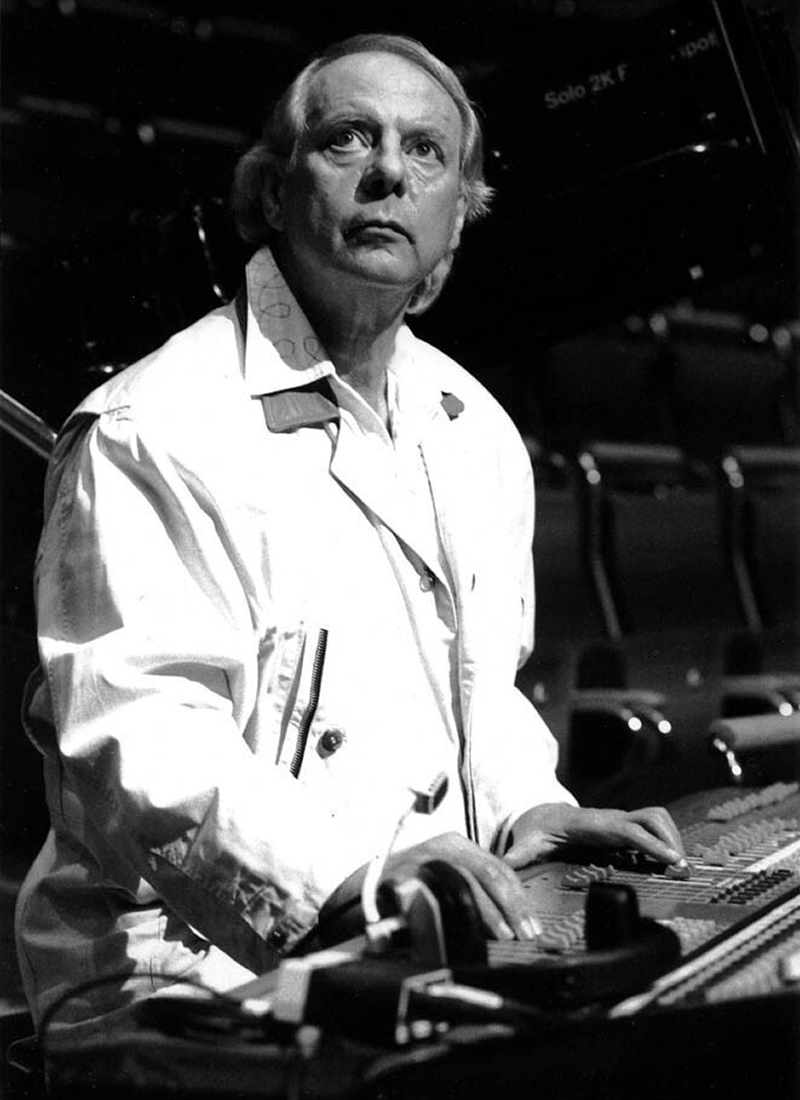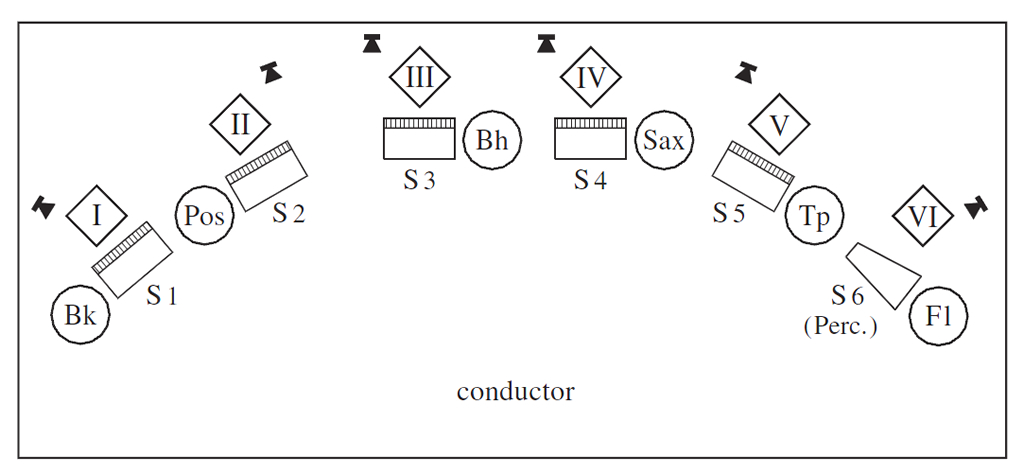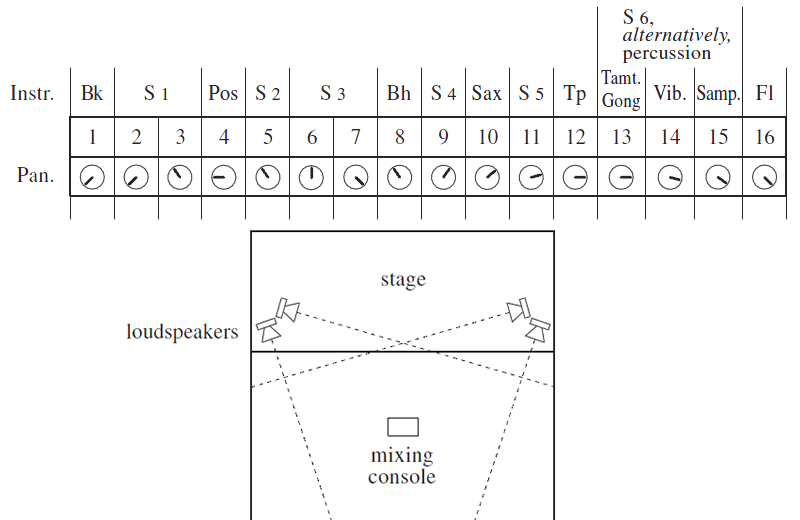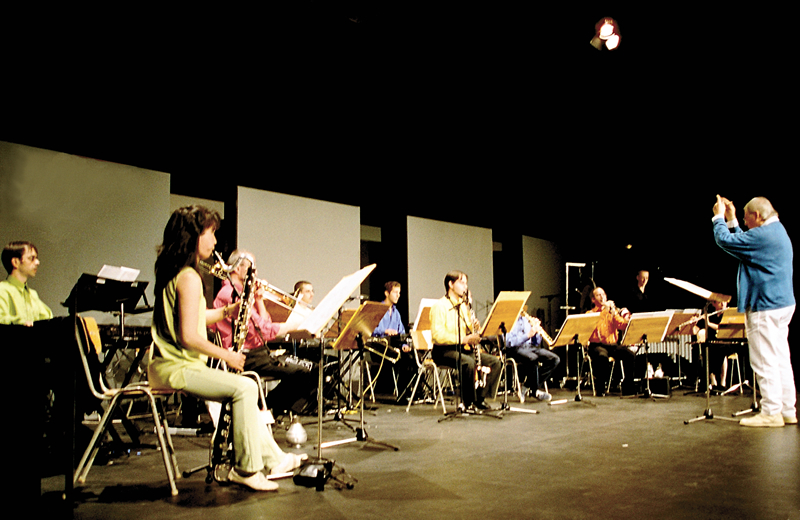
Instrumentation Works for Orchestra
Stockhausen Complete Edition on CD
Since 1991, a complete edition of all recordings in which Karlheinz Stockhausen has personally participated is being released on compact discs. Each CD in this series is identified by Stockhausen's signature followed by an encircled number. The numbers indicate the general historical order of the works.
Stockhausen realised the electronic music and participated in these recordings as conductor, performer, sound projectionist, and musical director. He personally mixed down the recordings, mastered them for CDs, wrote the texts and drew the covers.
- The compact discs may be obtained from the Stockhausen-Verlag: Kettenberg 15, 51515 Kuerten, Germany (www.stockhausenCDs.com).
Karlheinz Stockhausen
Instrumentation Works for Orchestra
STOP and START
Introduction
STOP and START
for 6 instrumental groups
(duration circa 21 minutes)
About the title
STOP and START is a model for the moment form. Groups of sounds of
changing densities are stopped by noises, and then – following each such
interruption – differently comprised sound groups start.
The STOP-noises are usually soft moments for concentrated listening.
They gradually become more rare, so that the fluency of the sound groups
develops organically.
Near the end, a secret children's song sounds "like wind" in agitated,
irregularly tremoloed dissonances above solemn bass tones.
STOP and always START again!
Origin
In 1965 I composed STOP for Orchestra. The instrumentation, choice of the pitches and timbres are determined by the conductor. In 1969, a Paris Version was made. It is published by Universal Edition, Viena (Austria). I conducted the London Version 1973 several times and recorded it with the London Sinfonietta ( CD 4 of the Stockhausen Complete Edition). Since then, several other versions have been made.
For the Stockhausen Courses Kürten 2002, I wrote a new score entitled
STOP and START for 6 instrumental groups:
| I synthesizer 1 and bass clarinet (S1 + Bk), |
| II synthesizer 2 and trombone (S2 + Pos), |
| III synthesizer 3 and basset-horn (S3 + Bh), |
| IV synthesizer 4 and saxophone (S4 + Sax), |
| V synthesizer 5 and trumpet (S5 + Tp), |
| VI synthesizer 6 and flute (S6 + Fl) |
 = all. = all. |
In this score, all details have been written out.
Depending on the circumstances, it is possible to use other instruments than
those indicated, if they have approximately the same register and are
dynamically well-balanced.
Also the number of instruments can be increased, if the balance among the groups is maintained.
The world première took place on July 27th 2002 in the opening concert of the Stockhausen Courses Kürten with the following performers:
| I Antonio Pérez Abellán (S1) + Rumi Sota-Klemm (Bk); |
| II Benjamin Kobler (S2) + Andrew Digby (Pos); |
| III Marc Maes (S 3) + Michele Marelli (Bh); |
| IV Josef Rebbe (S 4) + Julien Petit (Sax); |
| V Frank Gutschmidt (S 5) + William Forman (Tp); |
| VI Michael Pattmann (vibraphone, glockenspiel, and for the bass notes a sampler with keyboard) + Karin de Fleyt (Fl + alto flute) |
conducted by K. Stockhausen.
In group  I substituted synthesizer 6 with percussion in order to include Michael Pattmann, who gave a percussion course; however, a sixth synthesizer would be better for the balance.
I substituted synthesizer 6 with percussion in order to include Michael Pattmann, who gave a percussion course; however, a sixth synthesizer would be better for the balance.
A recording of STOP and START has been released by the Stockhausen-Verlag on compact disc 64.
Performance Practice
Set-up

 = monitor loudspeakers
= monitor loudspeakers
Sound Equipment
Each synthesizer player has a monitor loudspeaker beside him, which
should be powerful enough to enable abalance of all instruments in rehearsals and for performances in small halls. The monitor loudspeakers of these players should, if possible, sound equally loud when playing  or
or  . In addition, for performances in larger halls, all instruments must be amplified: the winds with 6 microphones, the percussion in struments with 3 microphones, and the synthesizers with leads to the mixing console in the hall.
(For the world première, S1 and S3 each had two leads, and S2, S4, and S5 each had one lead.)
. In addition, for performances in larger halls, all instruments must be amplified: the winds with 6 microphones, the percussion in struments with 3 microphones, and the synthesizers with leads to the mixing console in the hall.
(For the world première, S1 and S3 each had two leads, and S2, S4, and S5 each had one lead.)
All signals are circuited to a mixing console at the middle of the hall, where each has an individual fader and panorama potentiometer. There, they are mixed to stereo, dynamically balanced and projected over 2 x 2 loud speakers which are at the left and right above the stage, circa 4.5 m high.


Rehearsal preceding the world première of START and STOP on July 27th 2002 at the Sülztalhalle in Kürten.
Notation
Time
| 1 – 42 | = | numbered moments. The moments follow each other with out a break at a sign given by the conductor. |
 – –  |
= | 6 groups of instruments. |
 |
= | duration of 12 seconds. |
 START START |
= | Conductor starts a stop-watch (in his left hand). |
 STOP STOP |
= | Conductor stops the stop-watch. |
| 1'23" | = | 1 minute and 23 seconds from START until here. |
| ca. 37" | = | Conductor gives entry at about 37 seconds into the total duration of 83 seconds. |
 |
= | 7 beats of the conductor; the intervals of entry of the beats are free (if a tempo is not notated, as is the case between 19B and 20). He stops or starts groups with such beats. |
 |
= | quite long. |
 |
= | Conductor gives "soft" beat for a non synchronous stopping and starting of in struments (for example the transition from 5 to 6 etc.). |
| rit. | = | slow down to about half-tempo. |
| accel. | = | speed up from slow to fast. |
| IRR | = | irregular. |
| MORSE CODE | = | irregular rhythm, like Morse code. |
| REG | = | regular (periodic). |
| IND | = | individually (each player independently). |
| SYNCH | = | each entry is conducted. |
| STACC | = | relatively short sounds. |
 |
= | tenuto (do not shorten duration). |
| LEG | = | legato. |
| LONG | = | long sounds or noises. |
| CONT | = | sustained sound or sounds (with out interruptions, but not slurred). |
 |
= | repetition of the same pitch. |
 |
= | tremolo with 2 pitches. |
 |
= | gradual transition. |
 |
= | conductor gives entry. |
The traditional indications  and and  are used in a are used in amore general sense: there are irregular and regular (periodic) pitch repetitions and tremoli, i.e. slow ones, ones which accelerate, fast ones, and ones which slow down. |
||
 |
= | flutter- tongue (Flzg.) |
 |
= | pitch is sustained. |
 |
= | glissando. |
 |
= | caesura. |
Pitches
All pitches sound as written.
Included with the performance material is a part with transpositions for bass clarinet, basset-horn and soprano saxophone.
In the parts for these instruments, the synthesizer notes of groups  ,
,  , and
, and  are also transposed in the moments which are transposed.
are also transposed in the moments which are transposed.
If the soprano saxophone player can play other sections having lower pitches with a lower saxophone (for example, baritone), he (she) transposes these pitches him / her self.
Depending on the range of his instrument, each interpreter chooses pitches from those indicated, and changes them in any order, if not instructed otherwise. At the instruction change pitches with conductor SYNCH, the pitches may only be changed with each beat of the conductor.
Sounds – Noises
New, characteristic sounds should be produced by each synthesizer, which are also not imitations of any familiar sounds. The timbres should change as much as possible during the 42 sections.
Trumpet and trombone may use various mutes. At several places wawa mute and straight mute are prescribed for the trumpet, and wawa mute is prescribed for the trombone.
NOISES = All kinds of noises which can be produced by synthesizer or
sampler and instrument; they should be different in each noise
section, taking into account the prescribed dynamic level.





 = noise sections.
= noise sections.
The individual parts of the 5 synthesizers, as in the recording of the world première in 2002 ( CD 64 ) may be ordered from the publisher on 5 individual compact discs.
Dynamics
If several signs are indicated for dynamic levels, such as  /
/  /
/  /
/  /
/
 , then the player may begin at any level and freely permutate all of them.
, then the player may begin at any level and freely permutate all of them.